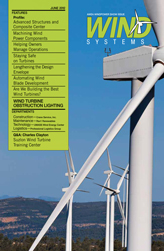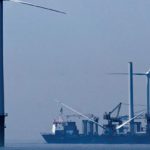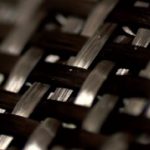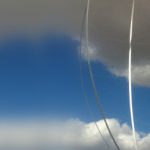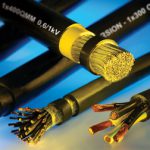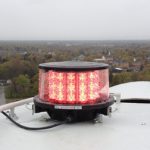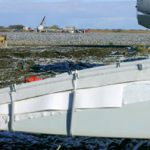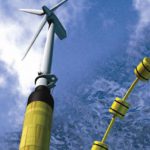It’s a daunting endeavor for a company to competitively and successfully develop longer, lighter and higher quality wind turbines in today’s economic and political climate with so many technical and financial risks at stake.
In this context, turning to automation for the design and manufacture of wind blades holds the promise of many advantages, including faster time-to-market, reduced engineering and production costs, enhanced quality and performance, and improved design tailoring capability.
In fact, the larger wind turbines become, the more critical it is to adopt automation. Labor-intensive processes don’t make sense economically in the long run. And with the wind industry developing increasingly complex blades that may soon reach 100 meters (or 328 feet) in length, a high degree of manufacturing automation is essential to ensuring the long term viability of this industry.
But proper adoption of automation requires a reassessment of the whole development process. Using automated manufacturing systems alone doesn’t guarantee that wind turbine-manufacturing firms will profitably meet the expanding demand for high quality blades. Indeed, without a way to rapidly optimize the designs for automated processes, accurately assess the producibility of wind blades and fully integrate the design, validation and manufacturing process, automated production systems represent an incomplete solution to a complex challenge. Figure 1
Enhancing the Power of Analysis
Composite wind blade designs offer huge advantages in terms of weight savings and durability. However, they also bring on unique challenges for the engineering analyst who has to ensure risk-free performance while dealing with complex shapes, thousands of plies, and properties that change along the entire length of the blade.
Because of this inherent complexity, composite design and analysis for wind turbine blades is a highly collaborative and iterative process. The process typically begins with early system level models that feed a computation fluid dynamics (CFD) analysis. Cross sections at various stages are derived and sent to the CAD and CAE teams. Sophisticated CAD applications are then used to generate the 3D model of the wind blade. For instance, NX® software from Siemens PLM Software can be interfaced directly with the system engineering solutions to read in scan lines or point cloud data and create a high quality surface through lofting and freeform modeling.
The early CFD analysis also provides the pressure loads that need to be mapped onto the blade for CAE analysis. So while the CAD team is busy generating the 3D model, the analysis teams can be working on preliminary sizing and optimization. Many CAE engineers use 1-D equivalent beam models for initial optimization and then build 2D models to represent the detailed structure.
The CAE applications for analyzing laminate composites derive the properties of the ply material based on defined properties for the fiber and matrix materials. They also support a range of theories that seek to predict ply strains and stresses and the onset of delamination or core failure. Typical simulations include evaluating stresses at the blade root and around bolted joints where the blade connects to the hub, vibration and modal analysis, and nonlinear buckling analysis of the skin. Additionally, engineers evaluate the blade for maximum tip deflection and fatigue loads. Since the blades are subjected to a wide range of load cases (wind direction, gusts, etc.), it is also useful to evaluate load case envelopes to identify overall margins of safety. Figure 2
The objective is to find an initial solution for where and how much material should be deposited and how it should be oriented in order to satisfy a range of performance criteria. The material and layup definitions also have a major effect on whether a part can be produced, hence the need for easy sharing of models and data between geometry design tools, CAE applications and specialized applications for composite design.
NX is a good example of an environment that supports the rapid iterations that are needed for composite blade design. Data generated in the NX CAD application is seamlessly made available within the NX CAE application, which includes a dedicated solution for the analysis of composites. Associativity is maintained throughout so that any change in design can be cascaded easily to update simulation results. Finally, the initial layup information generated in NX CAE can be shared bi-directionally with Fibersim™ composites engineering software from Siemens PLM Software.
Staying True to the Design
All too often what is being made in the factory is different from what was designed, analyzed and documented in the design office. Issues arise on the shop floor that were not expected and inevitably leads to design changes.
Software that provides the ability to perform a producibility simulation, such as Fibersim, enables an organization to verify early on in the development process that manufacturing will be able to make the parts as designed. For manufacturing organizations to be successful, designers and stress engineers must have access to producibility simulation data prior to the time their colleagues on the shop floor start manufacturing blades.
Indeed, in order to produce a wind blade to specifications with fewer risks and less waste, one should accurately simulate the manufacturing process and learn of potential problems during the time that early design and optimization are being conducted.
This is especially true for today’s football field-length blades because they are comprised of thousands of composite plies and core panels. Multiple materials, including glass and carbon fiber fabrics, various resins and bonding pastes, balsa and foam core may be used in a single blade. The ability to stack and stagger plies in different sequences and orient material fibers along specific directions enables the building of stronger and lighter blades, but it also greatly increases the amount of design and manufacturing data to deal with. Given the complexity of working with so many different materials, it is imperative to accurately simulate how they will fit together once it all hits the manufacturing floor.
By combining accurate simulation of various processes and materials and reducing the complexity for designers and structural engineers, such software solutions ensure that the components of a wind blade—skins, spar caps, web, box beam, and root laminate—will indeed be producible when manufacturing starts.
Such producibility simulation enables the timely discovery of potential problems, including fabric folding, wrinkling or bridging issues. These issues may result from excessive steering, pulling or pushing of the fabric while laying down plies or courses in the blade mold. Ultimately, it can trigger preliminary breakdown of the blade by progressive de-lamination, de-bonding and crack propagation, leading to catastrophic failure. Figure 3
If detected early by the producibility simulation, these issues can be resolved quickly by changing the ply design in various ways, including ply darting, splicing, re-draping, or material and orientation changes. This can all be done directly on the computer using Fibersim’s simulation capabilities, which drastically reduces the need for costly physical testing and shop floor rework.
What’s more, materials suppliers and transformers are constantly innovating with new types of fabric weaves or stack-ups which results in new forms of composite materials, some of which are tailored to large composite structures. Among them, Non Crimp Fabric (NCF) and multi-axial fabrics are now extensively used in the wind industry. Such materials present some new and very specific deformation behaviors when draped on the tool. For example, they are more prone to micro-buckling deformations. These deformation modes must be accounted for by the producibility simulation software in order to generate useful information for blades made with these new materials.
The benefits of producibility simulation have been proven in production across multiple industries by companies such as Bombardier Aerospace, BAE systems, Nordex, Sinomatech and others.
With the advent of automated deposition systems for wind blade layup operations, a complete and accurate producibility simulation capability is even more critical. That’s because in traditional manufacturing, the engineers and technicians who are confronted with manual layup issues on the shop floor will often have enough experience and knowledge to devise a workaround “on the fly” to get them over the hurdle. While this is less than ideal because it is not repeatable and increases the risks of an imperfect blade, at least it keeps the manufacturing process moving forward.
With automated deposition systems, the machine is unable to figure out manual workarounds “on the fly.” Events and alternatives are either pre-programmed or they are not. When the answer to an issue is not available, the machine stops, or may damage the part or the mold. Precious time is wasted halting the automated deposition process for lengthy manual interventions. Such downtimes are major productivity killers and the reason why some companies have delayed adopting automation.
In order to control the risks of new technology, such as automated deposition systems for wind blades, it is imperative to root the engineering process in a complete, accurate and reliable producibility simulation of the manufacturing process.
Avoiding Failure
As described in the previous sections, the laminate sizing and layup information along with the detailed surface representations are inputs for detailed laminate design and subsequent producibility simulations.
However, the material orientations derived from the draping simulations can vary enough from the initial definitions that an accurate final validation step is necessary. The detailed design will also have numerous ply drops and thickness variations that typically would not have been part of the initial sizing and optimization step. Figure 4
In the validation stage, high fidelity break-out models that use layered solid elements can be built. When physical test data is available, finite element models can be refined to correlate with the test results. These correlated models can then serve as a basis for detailed analysis and conducting tests in a variety of operating conditions up to the point of failure, which is prohibitive to perform on a physical part.
Incorporating Design & Manufacturing
So clearly, making sure that the part is optimized, verified, and fully producible is paramount before manufacturing starts. But there is another critical ingredient that is required to deliver an efficient and reliable blade manufacturing process: The adoption of an integrated design and manufacturing process.
Manufacturing teams making blades in the factory often encounter problems that stem from the fact that while some data may be available in the design office, either digitally or on paper or in the heads of the designers, some of that data has not made it to the shop floor. Or if it does make it, it is incomplete or not accurate enough for the manufacturing engineers to fully and precisely reproduce the design intent. They are left trying to figure out some of the details and fixing some of the apparent contradictions.
Furthermore, late modifications and design changes performed in the shop—sometimes major ones—are not communicated back to the design and analysis teams due to time pressure and other higher priority tasks.
An integrated design and manufacturing approach will remedy this type of situation.
Integrated design and manufacturing is a cornerstone of composites manufacturing. It is critical to reaping the expected benefits of automated deposition applied to wind blades.
For the automated manufacturing process of a blade to be reliable and lead to the expected time and cost savings, a complete, detailed and producible definition of the part must be communicated seamlessly from the 3D composite model to the digital manufacturing environment and, ultimately, to the machines. The goal is for the machines to produce the part exactly as designed.
A seamless link from the 3D composite model to the automated deposition system conveys consistent, complete and reliable data that reflects engineering intent, detailed ply and core layup definition, manufacturing constraints and exceptions handling.
Such a seamless link is illustrated by the connection between NX, Fibersim and the Tecnomatix® software for manufacturing simulation and planning, which allows the automated transfer of a producible wind blade design to digital manufacturing. By providing complete data about how the fabric should be laid down to avoid manufacturing problems, this link enables the fabrication of a wind blade by machine systems that can layup rolls of materials with significant time-savings compared to manual processes.
Staying True to the Plan
The wind industry is following in the footsteps of aerospace firms by moving to automated deposition of composite materials for large composite parts. While automating wind blade manufacturing can save time and reduce costs, there are significant risks if the machine system is not fed with the appropriate instructions from a producible part definition.
Within the Siemens PLM Software portfolio, composite design software, such as Fibersim, provides the ability to simulate the fabric deposition completely and accurately to ensure producibility of the design.
In addition, by combining Fibersim with the capabilities of NX CAE software for analysis and Tecnomatix Process Simulate integration, the organization can guarantee seamless communication of the detailed and validated design to the shop floor. This digital process ensures that the parts are manufactured as designed and analyzed.
Without such a blueprint, the costs could be high. Imagine a 70-meter long blade attached to a wind turbine that weighs more than several hundred tons and is raised almost 500 feet off the ground. Now imagine a failure in the blade structure. With structures as large as these, blade failure can cause catastrophic damage to lives or property. Failures can also lead to long shutdowns for costly repairs. What can engineers do to avoid blade failure? The answer is to adopt a well-executed product development process that integrates design with performance simulation and producibility simulation to catch all the problems before they arise.



















